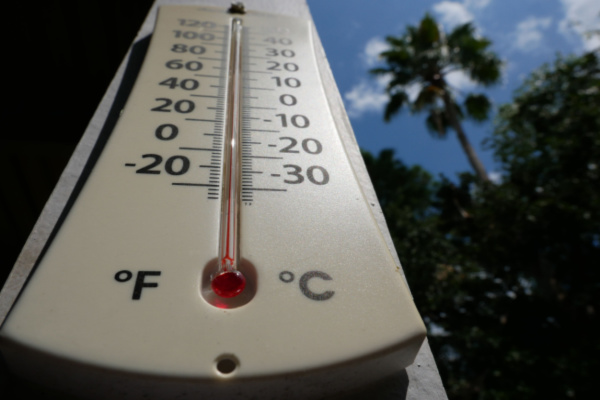The brutal heat wave punishing Texas is expected to worsen and expand in the coming days, according to forecasting models, before extending its reach to other states.
“The never-ending and dangerous heat wave in Texas will persist through the weekend into next week,” the National Weather Service said on its website. ” On Friday, Texas, Arizona, New Mexico and Oklahoma were all placed under heat alerts that are expected to last into this week.
Austin broke a record last week for its highest heat index value, blazing in at 118 degrees at Camp Mabry, according to the National Weather Service. Although heat index values, or the “feels like temperature,” are not an “official” record, National Weather Service meteorologist Mack Morris said this is the highest value ever detected in Austin. The previous high heat index value was 116 degrees in August 2016.
“This is not normal for June,” Morris said. “It does get hot, but this kind of humidity is not normal.” The weather service predicts these heat advisories and possibly additional excessive heat warnings will continue to be issued into next week and possibly longer with “no clear end in sight.”
Throughout the first half of the week, Austin and much of Central Texas were under an excessive heat warning as temperatures hovered around 104 and heat indexes reached near 115. On Saturday and Sunday, temperatures reached about 103, with heat indexes climbing to 112, at Camp Mabry, according to weather service forecasts.
Such stifling and even life-threatening conditions are expected to persist at least through this week. “The core of the heat may focus more over southern and western Texas late this week, before expanding again next weekend into the following week,” the National Weather Service said in a statement Wednesday.
As the heat wave expands, Oklahoma, Arkansas, Louisiana, Kansas and Missouri are all forecast to see triple-digit temperatures by the middle of next week. In all, more than 40 million people could find themselves under heat alerts before conditions abate, double the number of those already under one.
While recent rain — which at Austin-Bergstrom International Airport totaled nearly 1 inch Wednesday — might have seemed like a reprieve from scorching temperatures, it could push heat indexes higher. More rain means more water in the ground, which equals more humidity and, therefore, higher heat indexes. Morris said the humidity has been the driving force behind making this heat wave feel worse than previous ones. So, the recent rain could cause heat indexes to continue staying high as this heat wave continues.
“We’re getting these extreme heat indexes due in part to our fairly wet spring and recent rain,” Morris said. “Last summer was hot, but it was more of a dry heat. We didn’t have as much rain in the spring. So wasn’t as bad. This summer has been way worse already.”
Local officials urged residents to take proper precautions before heading outdoors by drinking plenty of water, staying out of the sun if possible, taking breaks and watching for signs of heat-related illnesses. Morris said this type of high-humidity heat is exceptionally dangerous because the body’s cooling system can’t work as well because sweat doesn’t evaporate as easily.
Heat claimed more lives in the U.S. than any other weather-related event in 2022 with 148 deaths, according to the National Weather Service. That’s nothing new, though, as heat has been the No. 1 cause of weather fatalities for 30 years, with an average of 164 deaths a year. “With this heat, in this humidity, it’s dangerous, and we need to pay attention to that,” Mayor Kirk Watson said during the news conference last week.
Morris said heat waves are only going to increase as the planet warms due to climate change. Climate Central, a nonprofit science organization, said climate change played an “exceptional” role in the scorching temperatures. The group’s Climate Shift Index map, which provides daily measures of how climate change is affecting air temperatures, showed that climate change made this week’s excessive heat warnings in Central Texas five times more likely to occur.
“People can say all they want about climate change. But the planet’s definitely warming, and we’re the cause of it,” Morris said.
“Climate change, as our own work shows, is leading to more of these very persistent ‘stuck’ summer jet stream patterns, where, for example, a big high-pressure system with hot sinking air gets stuck in one particular region of the country,” University of Pennsylvania climate scientist Michael Mann told USA Today. “That’s what happened during the 2021 Pacific Northwest heat dome and something very similar is playing out right now over the south central U.S. and northern Mexico.”
The Centers for Disease Control and Prevention (CDC) notes on its website that “more than 700 people die from extreme heat every year in the United States,” and studies have shown that the number will increase as climate change continues to worsen.
The agency provide valuable tips on how to protect against extreme heat events. These include staying in air-conditioned buildings as much as possible, not relying on fans as a cooling device, drinking plenty of water, limiting the use of stoves and ovens (which increase indoor temperatures) and wearing loose-fitting, lightweight clothing.
—
Photo Credit: Collective Arcana / Shutterstock.com
